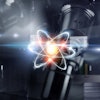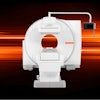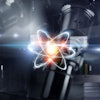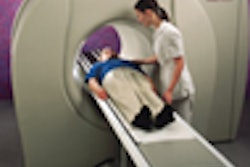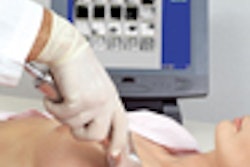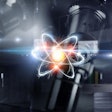SAN FRANCISCO - The images are fuzzier, but coincidence-detection style hybrid PET scanners are just as accurate as dedicated PET scanners for the diagnosis and staging of most bronchogenic carcinomas. That's the conclusion of researchers from the University Hospitals of Cleveland, who evaluated 23 patients with both systems.
At yesterday's PET imaging sessions of the Chest 2000 conference in San Francisco, nuclear medicine specialist Dr. Peter Faulhaber said the study was motivated by a lack of literature comparing the two technologies, and by the opportunity his institution afforded by having both kinds of scanners.
"We wanted to assess the difference between what's called dedicated PET (DPET) -- PET that's done with simultaneous 360° acquisition -- and hybrid PET (HPET), PET scanning done with a standard gamma camera," Faulhaber said.
Gamma cameras with a coincidence detection HPET upgrade are far less expensive than dedicated PET cameras, which sell for about $800,000 and up. HPET cameras produce lower-resolution images than dedicated scanners due to count rates only about a third as high. However, they are more versatile than dedicated scanners because they can be used in a variety of nuclear medicine applications, rather than just for high-energy imaging.
"This is the same camera you use for a bone scan or a cardiac scan or what have you," Faulhaber said. "Most places can have access to this kind of scanner rather than a dedicated machine. That's probably why there's a lot of interest now in hybrid PET."
Fluorine-18 deoxyglucose (FDG)-PET is emerging as an important tool in the diagnosis and staging of lung cancer due to a high sensitivity for most forms of the disease, variously reported at 85%-100%. In contrast, CT's sensitivity has been reported as low as 60%, with specificity as low as 40%, Faulhaber said. And FDG-PET results are reliable enough to preclude invasive biopsy procedures in many instances, especially when the result is negative.
"If you've got a negative PET scan, it's relatively safe to do a standard chest x-ray and CT follow-up, but it's very hard to get negative PET data because nobody will pay for the negative result," Faulhaber said. "If you look at HCFA guidelines, a negative PET is felt to be so good that HCFA won't even pay for a follow-up biopsy unless you have very good reasons -- for example, a lot of clinical suspicion for bronchoalveolar carcinoma."
The group prospectively evaluated 23 patients with lung masses that were newly diagnosed with chest radiography or CT. All patients underwent DPET and HPET on the same day.
DPET scans were begun 60 minutes following administration of 15-20 mCi of FDG, covering the area from the bottom of the larynx through the adrenal glands, Faulhaber said. On completion of the DPET scans, patients were brought over to the hybrid machine and rescanned, roughly two hours after intravenous administration of FDG. The emission-only images were not corrected for attenuation in either modality.
Two experienced physicians blinded to clinical and prior imaging results reviewed the HPET images, then the DPET images. Results were correlated with histopathology, and with CT results on an image fusion program, although it wasn't possible to fuse every image, Faulhaber said.
In results deemed positive or negative relative to the mediastinal blood pool, both DPET and HPET found 15 solitary pulmonary nodules (SPN) of 0.8 to 3.2 cm in size.
There was complete agreement for mediastinal uptake in 5 patients, and mediastinal involvement was shown in 2 patients who were negative at CT. Biopsies of 8 of 11 FDG-avid lesions also showed good correlation between the modalities (7 of 8 were malignant).
There were no false negatives, but one false-positive result -- a patient with Cushing's syndrome and a cavitary mass in the left upper lobe, which was subsequently removed.
For known non small-cell carcinomas, "we found the same staging results whether it was dedicated or hybrid," Faulhaber said. "I've found a couple of cases where I might have found one less lymph node with the hybrid instrument, but it didn't change the staging."
Faulhaber noted that the time lag between imaging sessions after FDG was administered (one hour for DPET vs. two hours for HPET) may be considered a study flaw. More time for soft-tissue clearance of the radiotracer could have influenced the results in favor of HPET.
Excellent correlation was achieved despite the hybrid instrument's "fuzzy" images, he said, noting that good image processing can do much to compensate for HPET's lower count rate. In addition, the CT fusion has proved useful for guiding highly targeted follow-up CT scans, and for directing a bronchoscopist to a specific region of interest, he said.
"We found that the hybrid scanner correlated quite well with the dedicated PET scanner," Faulhaber said. "In lesions as small as 0.8 cm we were able to accurately assess SPN, as well as accurately stage non small-cell lung carcinoma. They were in complete agreement at the primary site, occasionally [in agreement] at extra sites such as the contralateral lung, and [in agreement] at extrapulmonary sites such as wall metastases. We feel the use of hybrid PET will make the modality available to a larger number of patients, and perhaps broaden the application of PET in lung cancer overall."
By Eric Barnes
AuntMinnie.com staff writer
October 25, 2000
Let AuntMinnie.com know what you think about this story.
Copyright © 2000 AuntMinnie.com

